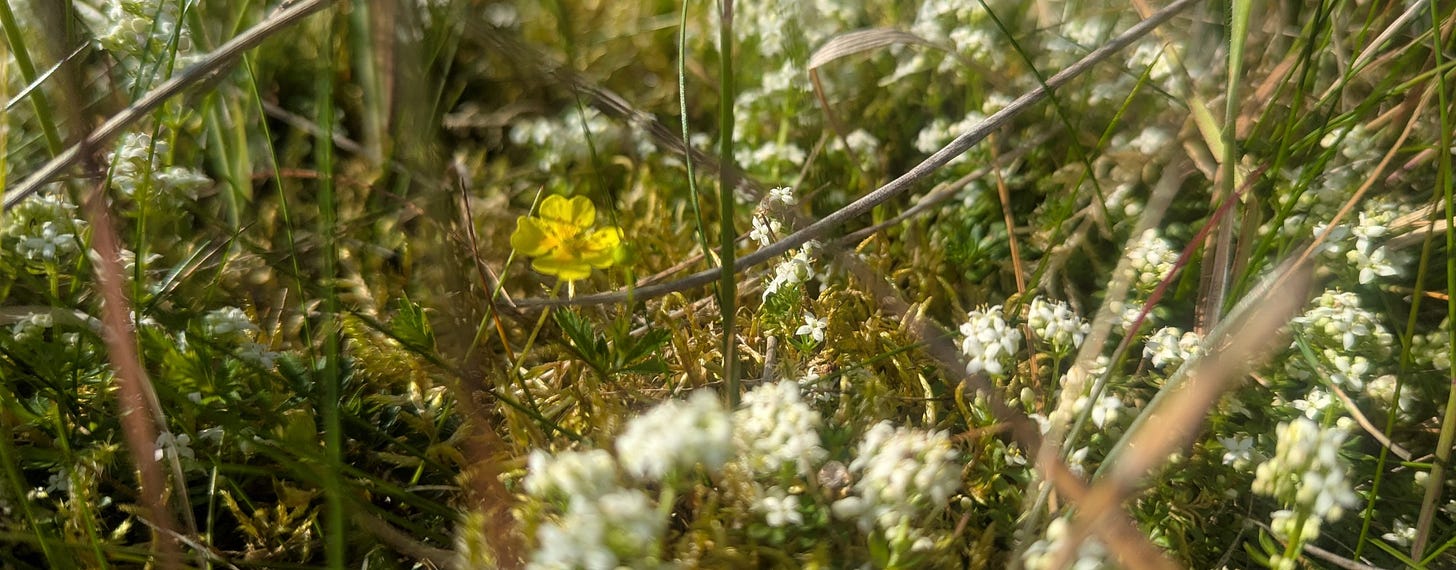Bedstraw and Bluebottles
Midsummer microseason in England's last wilderness
Up here in the North Pennines, numerous small changes herald midsummer’s coming.
The fells are blanketed in tiny white flowers of heath bedstraw, invisible until you look; when you do, they are everywhere. Yellow templar crosses of tormentil peer out from beneath.
Purple marsh orchids congregate along the roadside. The meadows glow with buttercup and rattle. The grass along the verges, reaching chest height, puts out seed-heads: a mauve-green-gold parade of fans, spears, pyramids, a dozen other forms, interspersed with clover and with bolting sorrel.
High beauty. A turning point.
My maudlin side regrets the passing of Spring, the bleaching of the green. Shoots overextend, dessicate, fall back to Earth. Holly faces oak. Our nights will grow longer.
When I open the van door a crack, a carpet of dozy flies crawl buzzing from the frame void. Have they arrived to escape wind and heat? Or were they born here? I suspect the latter.
I'm reminded of a favourite passage from M, John Harrison's short story A Young Man's Journey to Viriconium:
"I suppose you've got the same problem," I said to Mr Ambrayses. “I poison them,” I said, “but they don't seem to take much notice.” I held up the Vapona, with its picture of a huge fly. “Might as well try again.”
Mr Ambrayses nodded. “Two explanations are commonly offered for this,” he said:
“In the first we are asked to imagine certain sites in the world – a crack in the concrete in Chicago or New Delhi, a twist in the air in an empty suburb of Prague, a clotted milk bottle on a Bradford tip – from which all flies issue in a constant stream, a smoke exhaled from some appalling fundamental level of things. This is what people are asking – though they do not usually know it – when they say exasperatedly, ‘Where are all these flies coming from?’ Such locations are like the holes in the side of a new house where insulation has been pumped in: something left over from the constructional phase of the world.
“This is an adequate, even an appealing model of the process. But it is not modern; and I prefer the alternative, in which it is assumed that as Viriconium grinds past us, dragging its enormous bulk against the bulk of the world, the energy generated is expressed in the form of these insects, which are like the sparks shooting out from between two huge flywheels that have momentarily brushed each other.”1
This week in Whitby & Todmorden
This week we will be bringing the Crab & Bee folklore booktour to Yorkshire.
Whitby
On Monday 23rd June we’re in Whitby. A host of events are going off during the day to celebrate St. John's Eve / Ivan Kupala.
midday–2pm we’ll be at Whitby bookshop signing copies of the book. Just turn up.
4–9pm the folks from Whitby Krampus Run will be putting on a host of activities at Whitby Brewery, including making cyanotypes, flower crowns, music, dancing and drumming, and the moon on a stick.
6-8pm Crab & Bee will be staging a performance of their Matter of Britain, alongside storytelling, local history, and a performance by fabulous ethereal folk choir The Midsommars. Buy tickets here, only £3.
9pm onwards we'll be at the Abbey headland, partying as the sun sets 🌅
Todmorden
On Saturday 28rd June Crab & Bee will be guests of The Folklore Centre in Todmorden, from 4–6pm. Tickets here.
The Night
Alison Carr’s novella The Night is a fabulous archetypal story of a woman’s journey. I was blown away when I read it. We will soon be running a kickstarter campaign to publish it, sign up here for more info.
Elsewhere
Ted Gioa’s insights often stop me in my tracks. This post on what’s happening now is well worth reading:
In a later version of the story, renamed “A Young Man’s Journey to London”, the text is altered:
‘I suppose you've got the same problem’, I said to Mr Ambrayses. ‘I poison them,’ I said, ‘but they don't seen to take much notice.’ I held up the Vapona, with its picture of a huge fly. ‘Might as well try again.’
Mr Ambrayses nodded. ‘Two explanations are commonly offered for this,’ he said:
‘In the first we are asked to imagine certain sites in the world – a crack in the concrete in Chicago or New Delhi, a twist in the air in an empty suburb of Prague, a clotted milk bottle on a Bradford tip – from which all flies issue in a constant stream, a smoke exhaled from some appalling fundamental level of things. This is what people are asking – though they do not usually know it – when they say exasperatedly, “Where are all these flies coming from?” Such locations are like the holes in the side of a new house where insulation has been pumped in: something left over from the constructional phase of the world.
‘This is an adequate, even an appealing model of the process. But it is not modern; and I prefer the alternative, in which it is assumed that as London grinds past us, dragging its enormous bulk against the bulk of the world, the energy generated is expressed in the form of these insects, which are like the sparks shooting out from between two huge flywheels that have momentarily brushed each other.’



